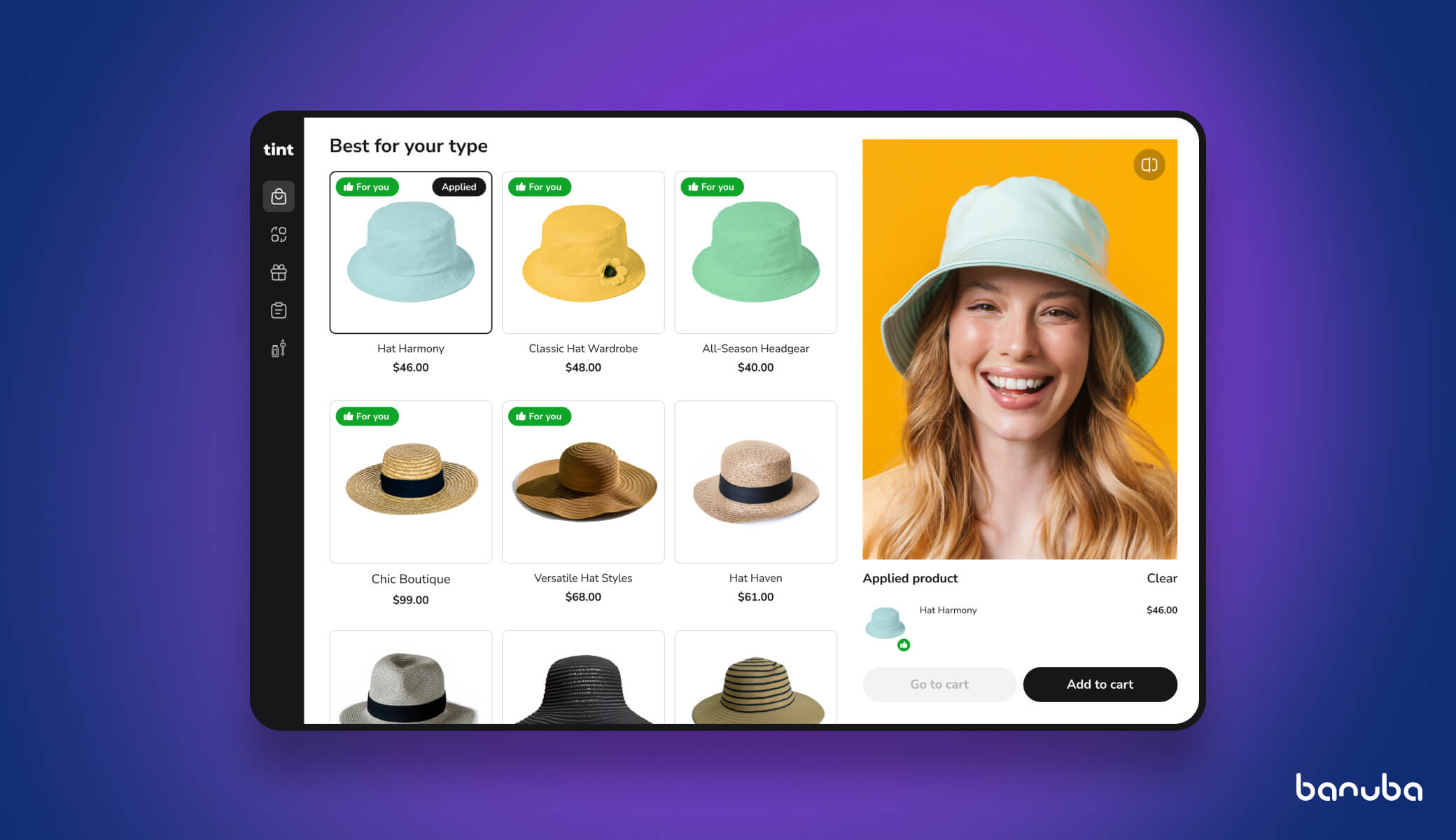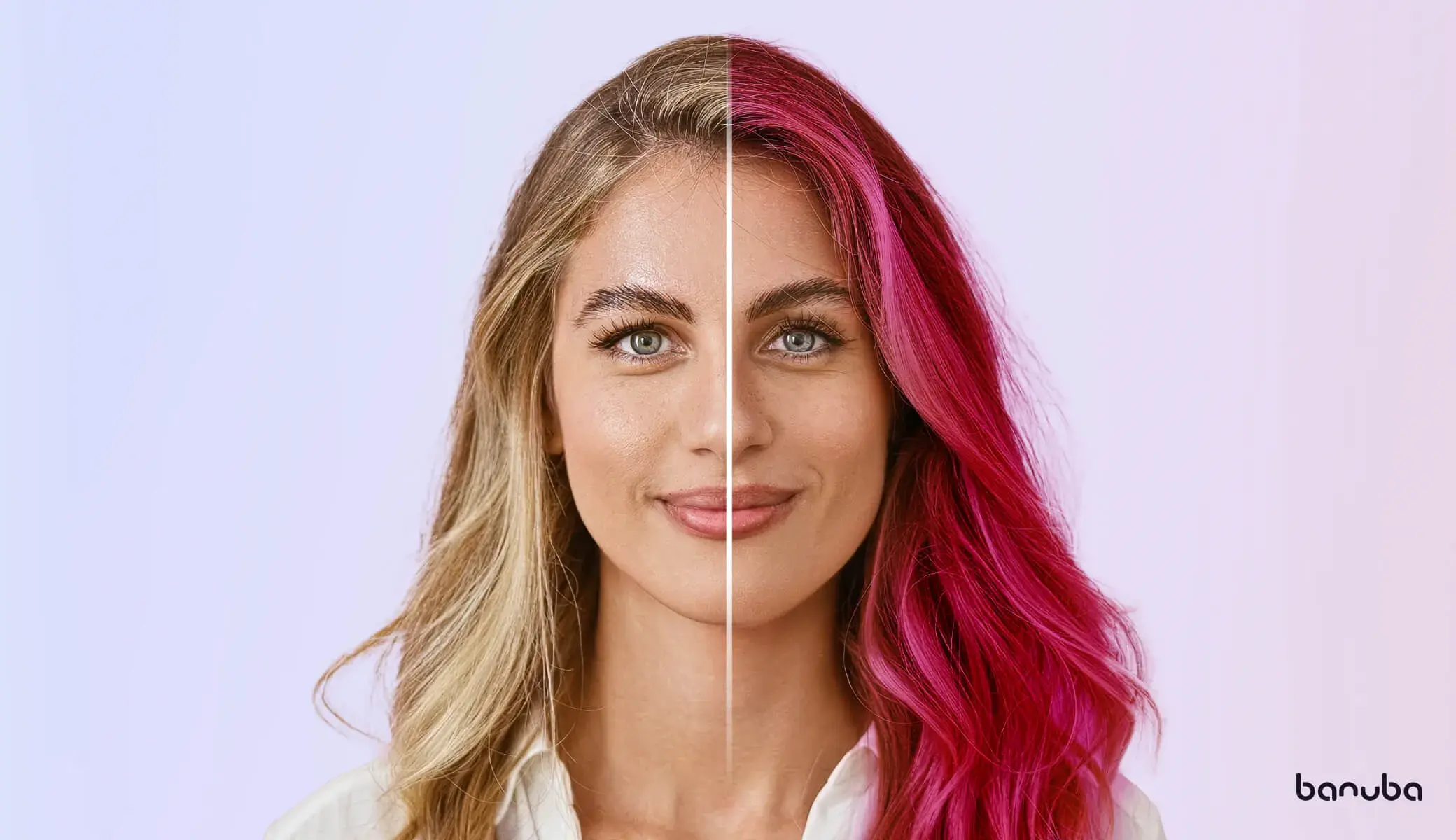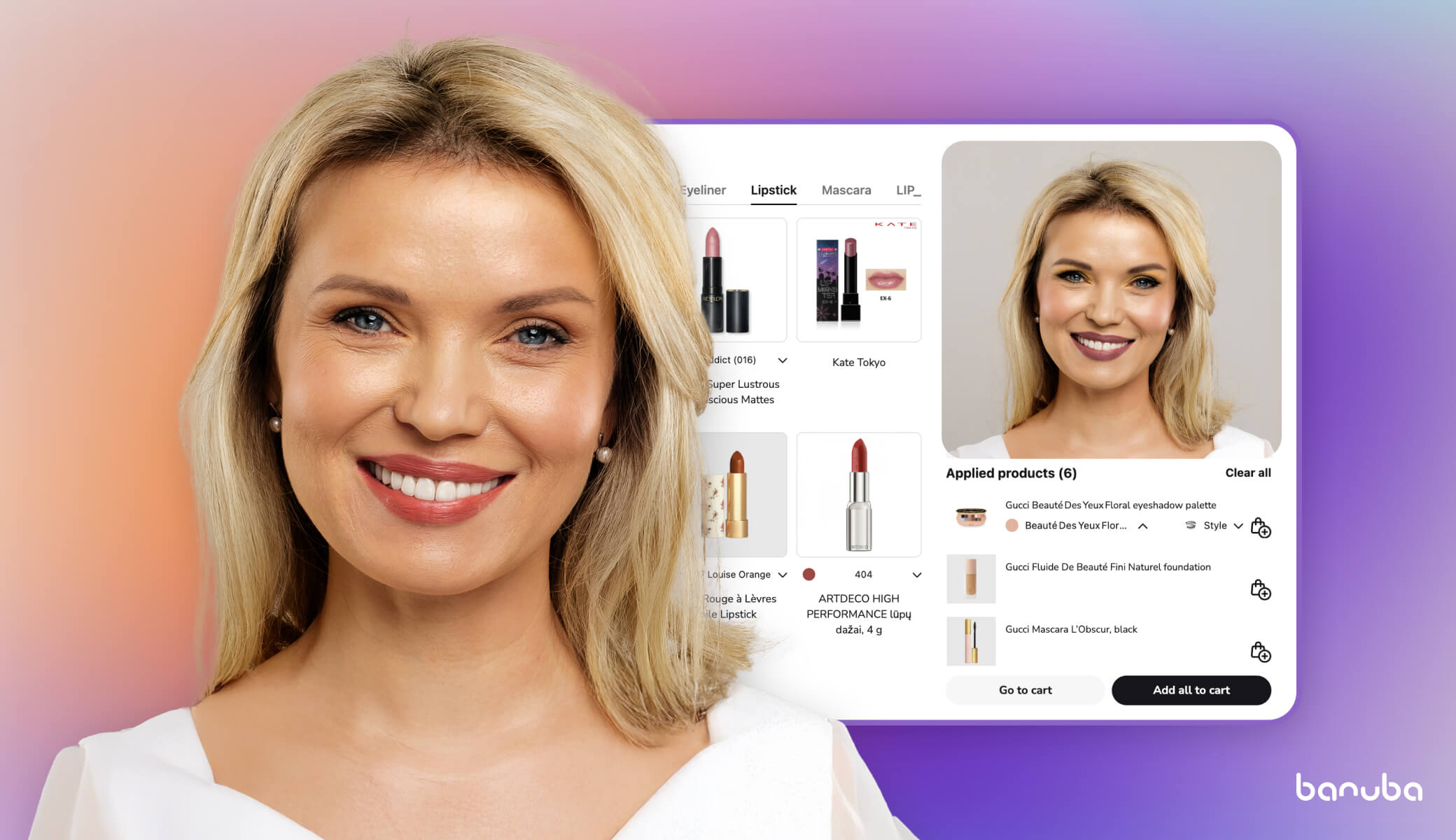Best Virtual Hat Try-On Solutions
The global virtual try-on market is expected to reach nearly $15 billion in value by 2029, eliminating customers' guesswork when shopping online and enhancing brands' image and revenue. While augmented reality and the virtual try-on experience have been in bloom for the beauty industry since COVID-19, their application in headwear sales and advertising is just taking baby steps. Keep reading to explore how brands and retailers can increase their conversion rate by up to 90% by introducing the hats try-on experience into their customer journey.

[navigation]
TL;DR
- Virtual try-on utilizes augmented reality and virtual overlays to help users envision how products will look on them before purchasing. The virtual try-on market is projected to reach nearly $15 billion by 2029, revolutionizing online shopping and enhancing brand revenue.
- Introducing virtual try-on to retail businesses can bring a substantial number of benefits, among which are:
- Enhanced customer experience
- Increased sales and higher conversion rates due to improved customer confidence
- Reduced order returns
- Broader market reach
- Valuable data insights for personalized marketing strategies
- Cost- and time-efficiency
- Virtual hat try-on can be used in a variety of scenarios like engaging marketing integrations, online shopping, smart mirrors, etc.
- Brands like Dior, Millinery Market, and Von Dutch Truckers successfully use virtual try-on for marketing and customer engagement.
What is a Virtual Try-On Technology?
Virtual try-on technology is a game-changer for retail businesses, especially when it comes to hats and head accessories. Imagine trying on countless styles and variations of headwear without ever setting foot in a physical store. That's the power of a virtual try-on experience.
Virtual try-on solutions use augmented reality (AR) or virtual reality (VR) to superimpose virtual images of hats onto a customer's head in real time or via overlaying them onto pictures. It typically involves using a smartphone, tablet, smart mirror, or computer with a camera. When a customer accesses the try-on feature through an app or website, the camera captures their image and overlays the chosen hat onto their head, allowing them to see how it looks from different angles and perspectives, depicting the detailed texture and try-to-life colors.
How Can a Virtual Hat Try-on App Benefit Retailers?
A virtual hat try-on app can bring retailers a multitude of benefits, revolutionizing their engagement with customers and business practices.
Enhanced Customer Experience
Virtual hat try-on platforms like TINT provide customers with an immersive and interactive shopping experience. According to statistics, 55% of users consider AR shopping more fun, and 29% of consumers want to interact with an item before purchasing it. By allowing customers to try on hats in real time virtually, retailers can offer a more engaging and enjoyable shopping experience compared to traditional online shopping methods.
Additionally, it removes the guesswork of texture and size. Users can experiment with various styles, download the images, and share them with friends, promoting UGC on social media.
Increased Sales
When customers can visualize themselves wearing a hat before making a purchase, they are more likely to feel confident in their decision. This increased confidence often translates into higher conversion rates, as buyers are more inclined to complete their purchase knowing how the hat will look on them.
Besides, augmented reality also promotes up- and cross-selling. Up to 72% of users commit to unplanned purchases while they only wanted to discover a new style or test the product. Almost half of shoppers are willing to pay more for a try-on experience.
Reduced Returns
One of the biggest challenges for online retailers, especially in the fashion industry, is dealing with returns due to items not meeting customer expectations. According to Statista, accessories are listed second after clothing, reaching 19% in returns.
Virtual hat try-on apps can help mitigate this issue by giving customers a better understanding of how the hat will fit and look on them, reducing the likelihood of returns due to sizing or style preferences.
Broader Market Reach
Virtual try-on apps can attract a broader audience of potential customers, including those who may be hesitant to shop for hats online due to uncertainty about how they will look. By offering a virtual try-on feature, retailers can appeal to a wider range of shoppers and expand their market reach. It is particularly valid for manufacturers of custom, unique, and high-cost hats and accessories.
Using AR in sales can also help brands engage other demographic categories of their target audience. For example, Gen Z claims that having product interaction through AR makes them 71% more likely to buy.
Data Insights
Personalization remains one of the trendiest approaches in marketing. Data-driven strategies have been proven to increase ROI by up to eight times. Virtual try-on apps can provide retailers with valuable insights into customer preferences and behavior. By tracking which hats customers are trying on, how long they spend using the virtual try-on feature, and whether they ultimately make a purchase, retailers, and brands can gain valuable data to inform their marketing strategies and product offerings.
Brand Differentiation
In a competitive retail landscape, offering a virtual hat try-on app can help retailers stand out from the crowd and differentiate their brands. By providing innovative and cutting-edge technology, retailers can attract tech-savvy customers who are drawn to brands that embrace innovation.
In 2020, only 1% or retailers featured AR solutions. However, Forrester predicts that the number will grow by 50% in 2024. Ignoring the virtual try-on experience today can leave many brands limping benind their competitors.
Cost Savings
While developing a virtual try-on app may require an initial investment, it can ultimately result in cost savings for retailers by reducing the need for physical store space and minimizing overhead costs associated with inventory management and logistics.
Recently, the try-before-you-buy trend has been gaining momentum, where shoppers can order a test batch of products and keep only the items they like or fit. This increases the risks of returns and logistics costs. Moreover, some products may be damaged and have to be disposed of. Virtual "testers" of headdresses can be sent by e-mail, investing the time of an e-marketer.
Besides, with off-the-shelf solutions like Banuba, retailers and hat manufacturers can save on the high-tag and long in-house software development. The integration takes only up to two weeks, and the solution is compatible with various devices - an iPhone, Android, smart mirror, or laptop.
Virtual Hat User Cases
Enough with the theory and figures. Let's explore how market leaders and innovative hat brands leverage the technology.
Marketing Integrations and Promotions
Social media platforms are one of the primary sources for generating leads and reaching the target audience. According to SnapChat report, four out of five brands use AR for increasing brand awareness. More than half of the Gen Z representatives would only pay attention to an ad if it features AR in it.
Facebook, Snapchat, TikTok, and Instagram became additional channels for interacting with retailers and producers, implementing the virtual try-on technology into interactive filters. Let's discover the best examples of virtual hat try on experience on social media.
Dior
Despite its elegance and prestige, Dior has never shied away from technological trends. In 2019, the design house posted hats and accessories from its fall collection, dedicated to Teddy Girls from the 1950s, on Instagram.
People were able to try on new models inspired by retro looks. Perhaps these virtual hats from 5 years ago may seem like accessorizing a character from the Sims game. However, today's virtual counterparts will amaze you with their realism.
Millinery Market
Millinery Market is a prime example of how modern technology can help you find extraordinary headwear for races or social outings without wasting time and trying it on.
The company sells handmade hats made to impress. Almost every product has a virtual hat analog in the form of a filter on Instagram, which allows you to try on different styles and pick a look from the comfort of your own home.
Stiksen
The Swedish cap maker has created a virtual showroom with try-on capabilities on instagram. While other companies and ecommerce reps offered try-before-you-buy with free shipping and return options, Stiksen simply added filters that allow potential buyers to evaluate the size, style, and pick the right cap color.
Von Dutch Truckers
Von Dutch Truckers is a renowned brand known for its iconic trucker caps that blend vintage Americana with contemporary streetwear. To promote the UGC creation, the brand intoruced their famous models on TikTok filters, leveraging the virtual try-on to reach the new generation of customers.
Online Shopping
The Coronovirus pandemic has forever changed shopping habits around the world. Lockdowns are over, brick-and-mortar stores are waiting with open doors, yet more than 70% of Americans still choose online shopping.
About 77% of shoppers use AR to try out different styles, check the size, and experiment with different colors. To our surprise, few merchants and stores offer their customers interactivity with their virtual goods. We have selected the most striking examples. The good news is that you can overtake your competitors and gain market share simply by integrating virtual try-on.
TRYO
TRYO can be described as a multi-brand virtual fitting room where shoppers can discover different styles and products — from caps and glasses to Gucci bags.
A user grants access to the camera and tries on various items in real time. The overlay may take a few minutes. Once a customer has made up their mind, they can be redirected to the online store to proceed to the checkout if the product is in stock.
DeCorina Hats
DeCorina Hats is a brand that specializes in crafting high-quality, handmade caps with a focus on style, sophistication, and elegance. Their website allows customers to try on the goods by uploading their image or taking one with a camera and placing the item over it. Shoppers can check out the size and style and download the edited image to share it with friends.
How to Implement Virtual Hat Try-On Apps?
Developing an app for virtual hat try-on from scratch can take more than six months, and the price starts at $150,000. In a fast-paced and competitive environment, even giants like L'Oréal, which is considered a technology leader in its industry, favor partnerships.
Finding, integrating, and customizing partner solutions is the best move for businesses of any size.
TINT from Banuba
Banuba's TINT platform owns patented face-tracking technologies and has already worked with Gucci and Samsung. The powerful rendering engine delivers realistic looks by adjusting for light, texture, and gravity. The platform is AI-powered, granting a data-driven approach to personalization.
Regardless of the camera on the device, the algorithm enhances the image and produces a result that is indistinguishable from the real product. Your whole collection can be digitalized in up to 48 hours to hit the virtual stores and generate UGC on social media.
The quick and easy integration takes up to 14 days, meaning getting your ROI almost straight away. Our analytics prove that using virtual fitting can increase engagement by 300% and boost conversions by 90%. TINT is compatible with cross-platforms and devices and can be customized to business needs. The software can be integrated into existing applications and platforms, acting as an additional step in the customer journey.
How Can Brands Leverage TINT?
- enhance brand awareness via social media using UGC;
- introduce an additional marketing and sales channel via a mobile app, in-store interactivity booth, or a virtual fitting room on e-commerce;
- promote new collections and products via collaboration with influencers just by sending them virtual hats via e-mail;
- throw promotional campaigns using smart mirrors and photobooths in malls and at events;
- use data insights for a more personalized customer interaction.
Request a demo to discover how you can free your customers from guesswork and the pain of choice, providing an interactive and fun shopping tool.






